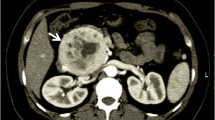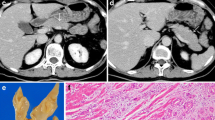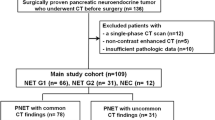Abstract
Objectives
Preoperative suspicion of malignancy in pancreatic neuroendocrine tumours (pNETs) is mostly based on tumour size. We retrospectively reviewed the contrast enhancement pattern (CEP) of a series of pNETs on multiphasic multidetector computed tomography (MDCT), to identify further imaging features predictive of lesion aggressiveness.
Methods
Sixty pNETs, diagnosed in 52 patients, were classified based on CEP as: type A showing early contrast enhancement and rapid wash-out; type B presenting even (B1) or only (B2) late enhancement. All tumours were resected allowing pathologic correlations.
Results
Nineteen pNETs showed type A CEP (5–20 mm), 29 type B1 CEP (5–80 mm) and 12 type B2 (15–100 mm). All tumours were classified as well differentiated tumours, 19 were benign (WDt-b), 15 with uncertain behaviour (WDt-u) and 26 carcinomas (WDC). None of A lesions were malignant (12 WDt-b; 7 WDt-u), all B2 lesions were WDC, 7 B1 lesions were WDt-b, 8 WDt-u and 14 WDC; 4/34 (12 %) lesions ≤2cm were WDC.
CEP showed correlation with all histological prognostic indicators.
Conclusions
Correlating with the lesion grading and other histological prognostic predictors, CEP may preoperatively suggest the behaviour of pNETs, assisting decisions about treatment. Moreover CEP allows recognition of malignant small tumours, incorrectly classified on the basis of their dimension.
Key Points
• Neuroendocrine pancreatic tumours (pNETs) show different post-contrast behaviour on CT.
• P NETs can be classified on the basis of contrast enhancement into three categories.
• CT classification of pNETs shows strong correlation with histological prognostic factors.
• CT pattern may suggest the optimal management of pNETs.







Similar content being viewed by others

References
Asa SL (2011) Pancreatic endocrine tumors. Mod Pathol 24(Suppl 2):S66–S77
Klöppel G, Rindi G (2010) The ENETS and AJCC/UICC TNM classifications of the neuroendocrine tumors of the gastrointestinal tract and the pancreas: a statement. Virchows Arch 456:595–597
Klöppel G (2011) Classification and pathology of gastroenteropancreatic neuroendocrine neoplasms. Endocr Relat Cancer 18(Suppl 1):S1–S16
Klimstra DS, Modlin IR (2010) The pathologic classification of neuroendocrine tumors; review of nomenclature, grading, and staging systems. Pancreas 39:707–712
De Lellis RA, Lloyd RV (2004) Pathology and genetics of tumors of endocrine organs. IARC, Lyons
Klöppel G, Rindi G (2007) Site-specific biology and pathology of gastroenteropancreatic neuroendocrine tumors. Virchows Arch 451(Suppl 1):S9–S27
Rindi G (2010) The ENETS guidelines: the new TNM classification system. Tumori 96:806–809
Rindi G, Wiedenmann B (2012) Neuroendocrine neoplasms of the gut and pancreas: new insights. Nat Rev Endocrinol 8:54–64
Edge SB, Byrd DR (2009) AJCC cancer staging manual, 7th edn. Springer, New York
Scarpa A, Mantovani W (2010) Pancreatic endocrine tumors: improved TNM staging and histopathological grading permit a clinically efficient prognostic stratification of patients. Mod Pathol 23:824–833
Hamilton NA, Liu TC (2012) Ki-67 predicts disease recurrence and poor prognosis in pancreatic neuroendocrine neoplasms. Surgery 152:107–113
Anlauf M (2011) Neuroendocrine neoplasms of the gastroenteropancreatic system: pathology and classification. Horm Metab Res 43:825–831
Schmitt AM, Anlauf M (2007) WHO 2004 criteria and CK19 are reliable prognostic markers in pancreatic endocrine tumors. Am J Surg Pathol 31:1677–1682
Ekebald S, Skogseid B (2008) Prognostic factors and survival in 324 patients with pancreatic endocrine tumor treated at a single institution. Clin Cancer Res 14:7798–7803
Fisher L, Kleeff J (2008) Clinical outcome and long term survival in 118 consecutive patients with neuroendocrine tumors of the pancreas. Br J Surg 95:627–635
La Rosa S, Klersy C (2009) Improved histologic and clinicopathologic criteria for prognostic evaluation of pancreatic endocrine tumors. Hum Pathol 40:30–40
Scarpa A, Mantovani W (2010) Pancreatic endocrine tumors: improved TNM staging and histopathological grading permit a clinically efficient prognostic stratification of the patients. Mod Pathol 23:824–833
Rodallec M, Vilgrain V (2006) Endocrine pancreatic tumours and helical CT: contrast enhancement is correlated with microvascular density, histoprognostic factors and survival. Pancreatology 6:77–85
Couvelard A, O’Toole D (2005) Microvascular density and hypoxia-inducible factor pathway in pancreatic endocrine tumours: negative correlation of microvascular density and VEGF expression with tumour progression. Br J Cancer 92:94–101
D’Assignies G, Couvelard A (2009) Pancreatic endocrine tumors: tumor blood flow assessed with perfusion CT reflects angiogenesis and correlates with prognostic factors. Radiology 50:407–416
Horton KM, Hruban RH (2006) Multi-detector row CT of pancreatic islet cell tumors. Radiographics 26:453–464
Pereira PL, Wiskirchen J (2003) Morphological and functional investigations of neuroendocrine tumors of the pancreas. Eur Radiol 13:2133–2146
Kulke MH, Anthony LB (2010) North American Neuroendocrine Tumor Society (NANETS). NANETS treatment guidelines: well-differentiated neuroendocrine tumors of the stomach and pancreas. Pancreas 39(6):735–752
Marion-Audibert AM, Barel C (2003) Low microvessel density is an unfavorable histoprostognostic factor in pancreatic endocrine tumors. Gastroenterology 125:1094–1101
Takahashi Y, Akishima-Fukasawa Y (2007) Prognostic value of tumor architecture, tumor-associated vascular characteristics, and expression of angiogenic molecules in pancreatic endocrine tumors. Clin Cancer Res 13:187–196
Jani N, Moser AJ (2007) Pancreatic endocrine tumors. Gastroenterol Clin N Am 36:431–439
Oberg K, Eriksson B (2005) Endocrine tumours of the pancreas. Best Pract Res Clin Gastroenterol 19:753–781
Rockall AG, Reznek RH (2007) Imaging of neuroendocrine tumours (CT/MR/US). Best Pract Res Clin Endocrinol Metab 21:43–68
Bergers G, Benjamin LE (2003) Tumorigenesis and the angiogenic switch. Nat Rev Cancer 3:401–410
Fidler JL, Johnson CD (2001) Imaging of neuroendocrine tumors of the pancreas. Int J Gastrointest Cancer 30:73–85
Koito K, Namieno T (1997) Delayed enhancement of islet cell carcinoma on dynamic computer tomography: a sign of its malignancy. Abdom Imaging 22(3):304–306
Ichikawa T, Peterson MS (2000) Islet cell tumor of the pancreas: biphasic CT versus MR imaging in tumor detection. Radiology 216:163–171
Anlauf M, Sipos B (2005) Tumors of the endocrine pancreas. Pathologe 26:46–51
Thoeni RF, Mueller-Lisse UG (2000) Detection of small, functional islet cell tumors in the pancreas: selection of MR imaging sequences for optimal sensitivity. Radiology 214:483–494
Moayedoddin B, Booya F (2006) Spectrum of malignant somatostatin-producing neuroendocrine tumors. Endocr Pract 12:394–400
Acknowledgments
The scientific guarantor of this publication is Salvatore Mazzeo M.D. The authors of this manuscript declare no relationships with any companies whose products or services may be related to the subject matter of the article. The authors state that this work has not received any funding. No complex statistical methods were necessary for this paper. Institutional review board approval was not required because our study is a retrospective review of standard preoperative CT examinations. Written informed consent was not required for this study because our study is a retrospective review of standard preoperative CT examinations. Methodology: retrospective, diagnostic or prognostic study, performed at one institution.
Conflict of interest
None.
Author information
Authors and Affiliations
Corresponding author
Rights and permissions
About this article
Cite this article
Cappelli, C., Boggi, U., Mazzeo, S. et al. Contrast enhancement pattern on multidetector CT predicts malignancy in pancreatic endocrine tumours. Eur Radiol 25, 751–759 (2015). https://doi.org/10.1007/s00330-014-3485-2
Received:
Revised:
Accepted:
Published:
Issue Date:
DOI: https://doi.org/10.1007/s00330-014-3485-2



